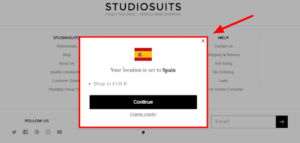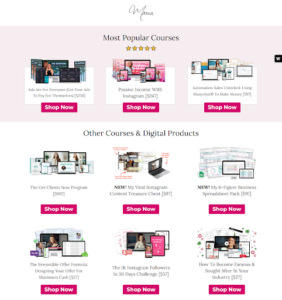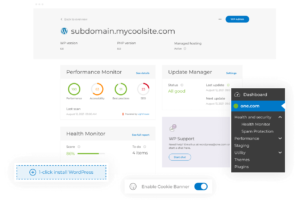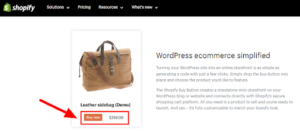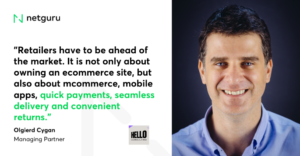Considering moving your in-person storefront online?
We’ve got the perfect mini-guide for you.
Read on to learn the benefits of transitioning from brick-and-mortar to e-commerce — and how to do it in three simple steps.
Top benefits of transitioning from brick-and-mortar to an online store
Here are three of the top benefits of transitioning to an e-commerce store.
Business continuity during crises
Most businesses never saw the pandemic coming. And pivoting online as quickly as possible wasn’t an option for some.
By setting up your e-commerce store now, you can carry on with business as usual in case of another worldwide shutdown or crisis.
For example, footwear retailer DSW compensated for a drop in in-store sales during the pandemic by encouraging customers to shop online.
The brand employed a two-pronged strategy to enhance the online shopping experience.
- It offered free shipping on all online orders and a 90-day return policy. Customers could exchange items that didn’t fit or weren’t what they expected.
- It introduced a curbside, contactless pickup and drop-off option. This helped customers safely pick up and return their items without entering the store or interacting directly with staff.
TL;DR: Pivoting to e-commerce helped DSW turn its plummeting sales around during the pandemic.
Global sales potential
Taking your business online gives more people the chance to find you. (Especially when you perfect your marketing strategy.)
Take StudioSuits, a men’s clothing brand, for example. By creating an online store, it can sell to customers worldwide.
The brand offers a variety of products, such as men’s custom green suits, tuxedos, blazers, and coats. Shoppers can quickly choose their currency and country to find and buy high-quality suits in their region.
TL;DR: Going digital has helped StudioSuits sell custom men’s fashion wear to a wider audience, fueling its growth and global sales.
Sales automation
Driving qualified leads to your online store and setting up tested funnels can help you automate sales. You can also sell digital products to eliminate extra steps in the fulfilment process and reduce overhead even more.
Take a look at Business Coach Maria Wendt’s online store, for example.
Maria sells over $300k worth of online products a month and has just hit her first $400k month.
All of the sales her business earns are completely automated. By setting up chat and email funnels, posting sales-eligible Reels on Instagram, and running ads, Maria earns money off digital products in her sleep.
TL;DR: Having an online business has helped Maria Wendt create a sales automation machine.
Transitioning to e-commerce
Now that you’re clear on some of the most note-worthy reasons to give e-commerce a chance, here’s how to transition from in-person to online sales:
Create your online store
Shifting from a physical store to an online shop requires a solid and adaptable platform.
WordPress is a fantastic choice for your e-commerce site because it’s flexible and has many plugins.
To maximize the benefits of using WordPress, getting WordPress-managed hosting is crucial. This specialised service takes care of important tasks like updates, security, and optimising your site’s performance.
With WordPress-managed hosting, you can build your own custom site that runs fast and offers a secure and reliable shopping experience. This is crucial to keeping customers happy and inspiring sales.
To make your site shoppable, simply add check-out page software or connect to an e-commerce platform like Shopify. For instance, with the Shopify Buy Now button, you can create a standalone mini storefront on your WordPress website.
How to ease your way into e-commerce
If possible, open your online store while you still have your physical storefront. This will allow you to take advantage of foot traffic and inform in-store shoppers about your new online shop.
Pass out business cards with QR codes when customers walk in or out so they can quickly access your e-commerce store. You can also create a native mobile app and encourage shoppers to sign up for push notifications for special discounts and prizes.
Set up your customer support options
When you lose the human touch you get from in-person shopping, you need to make up for it with reliable customer support.
Choose from self-service options, such as help center articles, automated options, like AI-assisted chatbots, and traditional options, like call center reps.
You can also offer customer service via email, online forms, and social media. The more touch points you give shoppers, the more supported you’ll help them feel.
Perfect the customer experience
Speaking of feeling supported, go the extra mile by making the customer experience feel pristine.
Accept a variety of payment options, including fast options, like Apple Pay, and pay later options, like Sezzle or Affirm. Be sure to also offer fast shipping options and make returns super easy and convenient.
Get the word out
Create a multi-channel marketing strategy to put your online store in front of as many eyes as possible.
Consider the following methods:
- Sales automation: Use sales funnels, quick buy buttons, and ads to automate sales.
- Email marketing: Keep loyal and potential customers informed about new products and special offers.
- Social media marketing: Build your online social presence with organic content and email marketing lead magnets.
- Micro-influencers and affiliate marketers: Partner with brand ambassadors to expand your reach and visibility.
- User-generated content (UGC): Excite customers to share their experiences with your products to build trust and authenticity. Repurpose UGC across your marketing channels.
- SEO (on and off-page): Optimize your website structure and content for search engines and build quality backlinks to improve your site’s visibility and rankings.
Wrap up
And there you have it. Refer to the three simple steps in this guide to transition from in-person to online sales.
Don’t forget to bookmark and print this article for easy reference.
Author Bio:
Ioana Wilkinson
Ioana is a business strategist and content writer for B2B tech and SaaS brands. She also helps aspiring entrepreneurs build remote businesses. Born in Transylvania and raised in Texas, Ioana has been living the digital nomad life since 2016. When she’s not writing, you can catch her snorkelling, exploring, or enjoying a café con leche in Barcelona!
Help keep news FREE for our readers
Supporting your local community newspaper/online news outlet is crucial now more than ever. If you believe in independent journalism, then consider making a valuable contribution by making a one-time or monthly donation. We operate in rural areas where providing unbiased news can be challenging. Read More About Supporting The West Wales Chronicle























